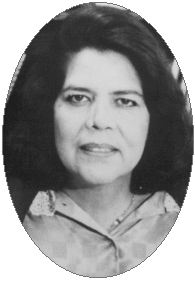
Wilma Mankiller was elected to the position of principal chief of the Cherokee Nation in 1987, when she won in her own right after taking over for Ross Swimmer mid-term in 1985. Mankiller had always felt restricted in her position as interim chief because she thought it was her duty to continue former Chief Swimmer's policies. Although, with the mandate from her people, she was free to carry out all of her policies and ideas that she considered as vital to the tribe's continuing growth. When Mankiller decided to run for another 4-year term in 1991, her victory was called a landslide. She had received 82.7 percent of the vote. Obviously, Mankiller did not arrive at this highest honor and level of office overnight. She had to overcome many obstacles in her life - in politics, in society, and within her own family. To see more about these hardships, click here.
Early Years of Poverty
Wilma Mankiller was born on November 18, 1945 in Tahlequah, Oklahoma to Irene and Charley Mankiller. Pearl, as she was called during her childhood, would be the sixth out of eleven children in the Mankiller household. Her family was always poor, but then so were most of the people in the community of Rocky Mountain. Mankiller related in her autobiography that: We were not well off, at least when it came to money. Like many of the people in Adair County, we were really poor - 'dirt poor' is how they say it in Oklahoma. I suppose there are degrees of povery just as there are degrees of wealth. If so, we were on the bottom rung of the poverty ladder.
In spite of this, the Mankiller family had a strength to survive that sometimes came through sheer will alone. Mankiller's father Charley and other relatives helped with the construction of the Mankiller's first real family home. The house was made of rough lumber and had only four rooms (Mankiller would later describe it as a "little bitty house with too many people living there - and more to come"). There was no electricity in the house, and the family had to use wood, coal, oil, and natural gas to cook and heat the house. Due to the fact that the house also did not have running water, they had to bring water up from a spring for cooking and washing purposes, and use an outhouse to go to the bathroom. Though the home lacked some luxuries, Mankiller looks back on her time there with pleasant memories. However, some memories were not as pleasant as the pride in a family home. To obtain the money needed for basic necessities, Mankiller's parents and older siblings used to go out and cut timber to sell as railroad ties. To further supplement the family's income, Charley Mankiller and his oldest son went every year to help harvest broomcorn, generally working every day from dawn to sunset. And her family's strength and perseverance paid off. Mankiller attested to her family's strength when she stated that "even though we were poor, I cannot remember ever being hungry as a little girl. Somehow, we always had food on our tables." Mankiller would feel no different from others until the family was relocated to San Francisco, California. That metropolitan setting opened her eyes to many injustices that existed in society and led the way for her focus on activism.
Policy of Termination
Wilma Mankiller and her family lived in Oklahoma until October, 1956, just shy of Mankiller's eleventh birthday. It was at that time that the federal government came up with a policy of "termination" of tribes to mainstream Native Americans. This policy was trumped up as a "wonderful opportunity for Indian families to get great jobs, obtain good education for their kids, and, once and for all, leave poverty behind." In truth, the program gave the government the perfect chance to take Indian people away from their culture and open up the vast Oklahoma territory to white land owners. Wilma Mankiller's father and mother reluctantly decided to accept the government's proposal with the hope of pulling the family out of poverty. Mankiller stated that "I experienced my own Trail of Tears when I was a young girl. No one pointed a gun at me or at memnbers of my family. No show of force was used. It was not necessary" for the government used "promotional brochures showing staged photographs of smiling Indians in 'happy homes' in the big cities." Even as a child, Mankiller had her doubts about the relocation. These doubts were realized when the Mankiller family arrived in San Francisco and discovered that the situation was not as portrayed. The family would have to become used to living in the ghetto, dealing with racism, and the loss of a sense of community, along with dealing with the extreme culture shock of a big city. Mankiller and her family had left behind: the sounds of roosters, owls, crickets, and other animals moving through the woods. Now we heard traffic and other noises that were foreign. The police and ambulance sirens were the worst. We had never heard sirens before. I thought it was some sort of wild creature screaming.
The sense of community would soon be found with the help of the San Francisco Indian Center, where the family met and spent time with other native people living in the area. It was here that Wilma Mankiller's activism would begin to form. To learn more about Wilma Mankiller's activism, click here!